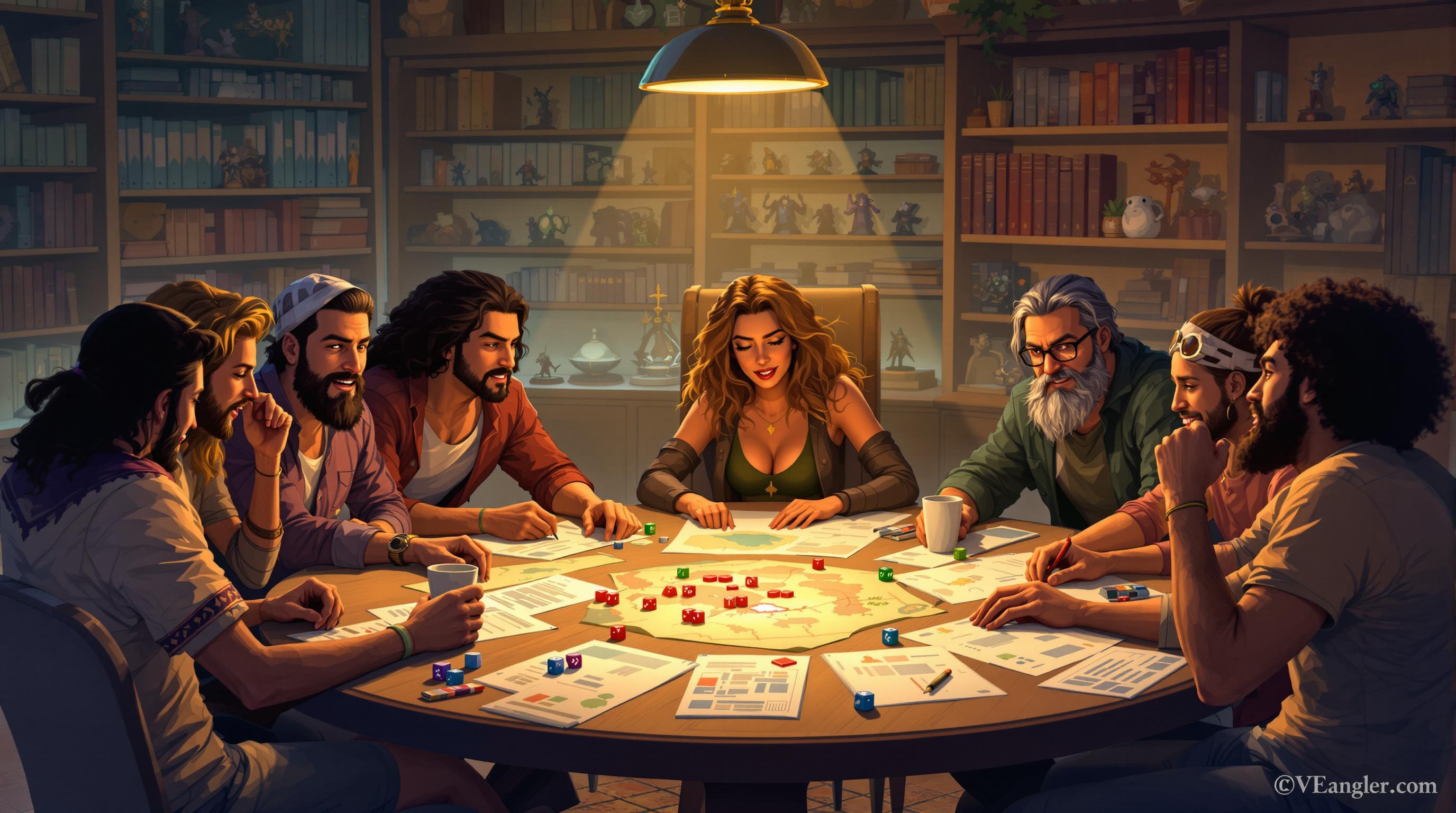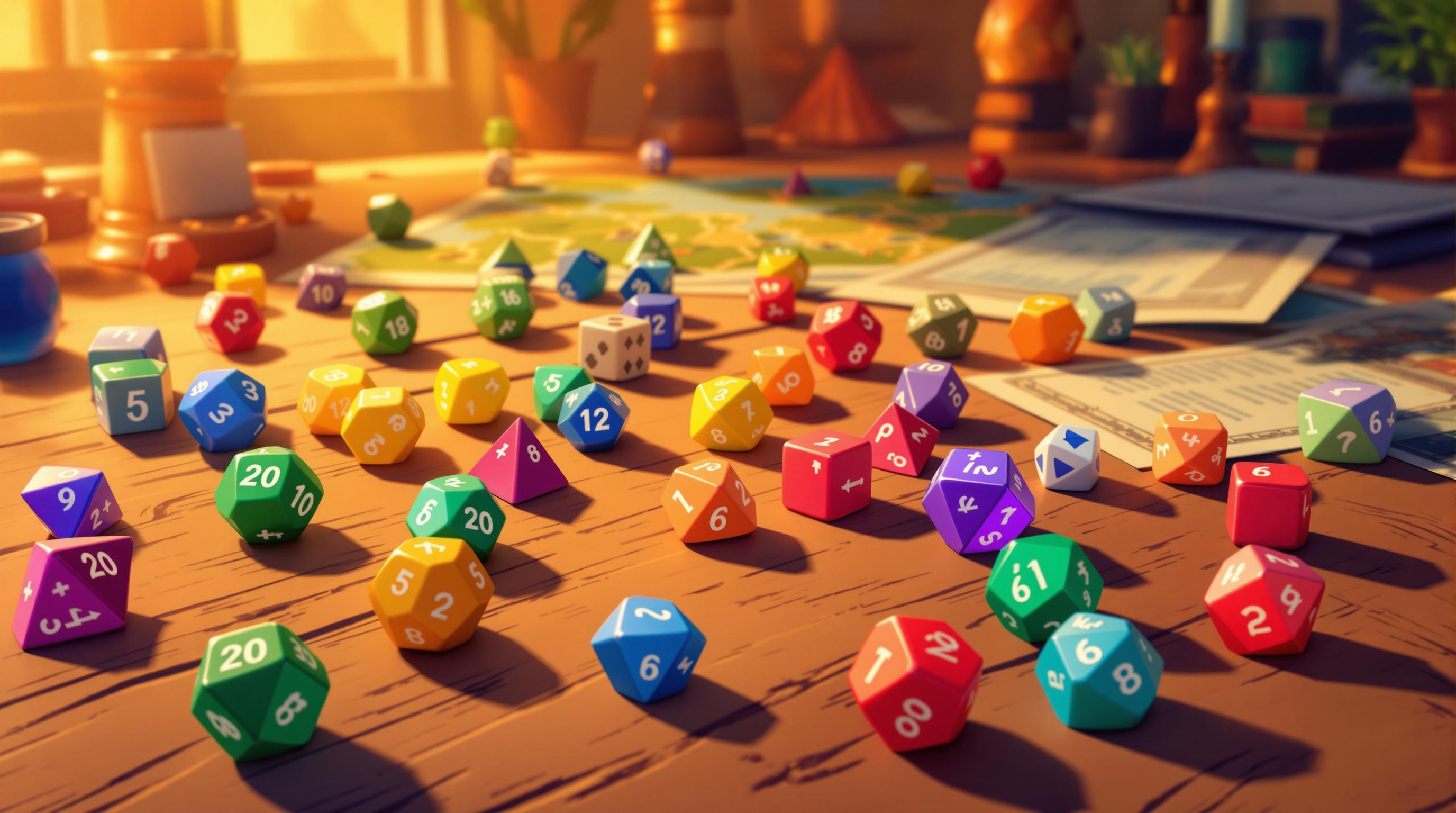Choosing the right RPG system depends on how complex you want the rules to be. Here's a quick breakdown to help you decide:
- Rules-Light Games: Simple, fast to learn, and focus on storytelling. Examples: Fate Core, Honey Heist.
- Medium-Complexity Games: Balance between accessibility and depth. Examples: D&D 5E, World of Darkness.
- Rules-Heavy Games: Highly detailed mechanics for tactical play and customization. Examples: Pathfinder 2E, GURPS.
Quick Comparison
| Complexity Level | Learning Time | Prep Time | Focus | Example Games |
|---|---|---|---|---|
| Simple | 1–2 hours | Minimal | Storytelling | Fate, Lasers & Feelings |
| Medium | 8–12 hours | Moderate | Balanced | D&D 5E, Call of Cthulhu |
| Complex | 20+ hours | Extensive | Tactics | Pathfinder 2E, GURPS |
To pick the best RPG for your group:
- Know Your Play Style: Tactical combat? Story-driven? Choose accordingly.
- Consider Player Skill Levels: Beginners? Opt for simpler systems.
- Factor in Time: Limited time? Go for rules-light games.
This guide helps you match your group's needs with the right RPG system for an enjoyable experience.
Related video from YouTube
What Makes RPG Rules Complex
The complexity of RPG rules comes from various factors that shape how the game is played and experienced. Understanding these factors can help you find a game that suits your preferences. Let’s break down the key elements that contribute to the complexity of RPG rules.
Basic Terms: Rules-Light vs. Rules-Heavy
In a rules-light system, the focus is on storytelling and creativity. These games rely heavily on the game master's judgment and player imagination, with minimal mechanical structure. On the other hand, rules-heavy systems offer detailed mechanics to cover a wide range of scenarios. While these provide more structure, they also require more time to learn and prepare. Some games mix these styles to offer a middle ground.
How Rules Shape Gameplay
The complexity of rules plays a major role in areas like character creation, combat, storytelling, and the game master's preparation. For instance, Pathfinder 2nd Edition uses a feat-based system for character creation, offering players a wide range of customization options. This level of detail can enhance gameplay but also demands more effort to master.
Comparing RPG Rules Complexity
Different RPG systems cater to varying levels of complexity:
- D&D 5E strikes a balance, offering enough depth for experienced players while being accessible to beginners.
- World of Darkness games lean into intricate rules to support their gothic-horror themes.
- Powered by the Apocalypse systems prioritize narrative freedom with simple mechanics.
To choose the right game, consider using tools like the TTRPG Games Directory to compare systems. Look at factors such as core mechanics, customization options, combat strategy, and how much preparation is needed. These details can help you match a system to your group’s preferences.
Many modern RPGs also include modular rules, allowing players to adjust the complexity without losing the core essence of the game.
Know Your Group's Needs
Now that you understand how the complexity of rules can impact gameplay, it's time to evaluate your group's preferences to find the right system for your sessions.
Pick an RPG system that aligns with your group's dynamics and comfort level when it comes to complexity.
Match Your Play Style
Does your group prefer intense, strategic combat or a focus on storytelling? For those who thrive on tactical combat, detailed systems like Pathfinder 2nd Edition deliver in-depth mechanics for strategic play. On the other hand, if storytelling is the priority, rules-light systems like Fiasco shift the focus to narrative rather than crunching numbers.
Here’s a quick guide to match systems with play styles:
| Play Style | Complexity | Examples |
|---|---|---|
| Combat Tactical | High | Pathfinder 2E, Warhammer FRP 3E |
| Story-Driven | Low to Medium | Fate Core, Seventh Sea 2E |
| Character Development | Medium | D&D 5E, RuneQuest |
| Horror/Mystery | Medium | Call of Cthulhu 7E |
| Sci-Fi/Technical | High | Eclipse Phase, GURPS |
Once you’ve identified your group's play style, factor in their experience levels to narrow down the options further.
Player Skill Levels
The experience level of your group plays a big role in choosing the right system. For groups with mixed experience, look for systems that offer flexibility in complexity. D&D 5th Edition is a great example - it provides simple rules for beginners while including optional advanced mechanics for seasoned players.
If your group includes newcomers, prioritize systems with:
- Clear and organized rulebooks
- Core rules that can be learned quickly
- Pre-made character templates
- Easy-to-understand mechanics
Time Requirements
Another key consideration is how much time your group can dedicate to learning and preparing for the game.
| Complexity | Learning Time | Prep Time | Examples |
|---|---|---|---|
| Simple | 2-4 hours | 30-60 minutes | TinyD6 |
| Medium | 8-12 hours | 2-3 hours | D&D 5E |
| Complex | 20+ hours | 4+ hours | Ars Magica 5E |
For groups with limited time or infrequent sessions, simpler systems offer more time for actual gameplay. On the flip side, if your group enjoys diving into intricate mechanics and has the time to invest, complex systems like Eclipse Phase or GURPS can be incredibly rewarding.
sbb-itb-b8b00a5
RPG Systems by Complexity
This section breaks down RPG systems based on complexity, helping you find the right fit for your group.
Simple RPGs
Simple RPGs focus on quick setups and easy-to-understand gameplay, making them perfect for beginners or one-off sessions. For example, Honey Heist keeps things light with straightforward mechanics, making it a great choice for newcomers. Similarly, Lasers & Feelings simplifies space adventures with a clever system where players choose between precision (Lasers) and intuition (Feelings).
If you're looking for a bit more depth without overwhelming complexity, check out medium-complexity systems.
Medium-Complex RPGs
These systems offer a middle ground, balancing accessibility with opportunities for strategic play. Dungeons & Dragons 5th Edition (D&D 5E) is a great example, offering a mix of simple core rules and optional layers of complexity. Pathfinder 2nd Edition provides even more customization and strategic options for those who want a bit more challenge.
Complex RPGs
For those who enjoy diving into intricate systems, complex RPGs deliver highly detailed mechanics and customization. Shadowrun (6th Edition) immerses players in a rich cyberpunk world with layered rules. Meanwhile, GURPS is a modular system designed to adapt to nearly any genre or setting, offering unmatched flexibility for experienced players.
The table below highlights the key features of each complexity level:
| Complexity Level | Key Features | Example Games |
|---|---|---|
| Simple | Easy rules, quick setup | Honey Heist, Lasers & Feelings |
| Medium | Balanced mechanics with optional depth | D&D 5E, Pathfinder 2E |
| Complex | Detailed rules and high customization | Shadowrun 6E, GURPS |
For more details on game mechanics, player reviews, and updated ratings, visit the TTRPG Games Directory. Use this guide as a starting point to find the perfect system for your group, and explore further resources to fine-tune your choice.
RPG Selection Resources
Once you've figured out your group's needs and the complexity level you're comfortable with, it's time to choose the right tools to narrow down your RPG options. These resources can help you make better decisions by aligning game mechanics with your group's preferences.
TTRPG Games Directory
The TTRPG Games Directory is an extensive resource featuring a wide range of tabletop RPGs. It breaks down each game's mechanics, themes, and features, making it easier to compare and evaluate options. Here's what you can focus on when using the directory:
| Feature | What to Consider |
|---|---|
| Mechanics Overview | The core rule systems and how complex they are |
| Learning Curve | How much time it takes to understand the rules |
| Character Creation | The level of detail and choices available for characters |
| Combat Systems | The depth of tactics and how the rules interact |
| Game Master Tools | The resources needed to manage and run the game effectively |
Decision Tools and Reviews
If you're looking for more structured guidance, decision tools can be a big help. For example, RPG Research provides a tiered evaluation system that ranks games based on their complexity and accessibility. This can give you a clear idea of the time and effort required to learn and run a particular game.
Reviews and comparisons are another valuable source of information. Pay attention to factors like the complexity of character creation, how often the rules make exceptions, and the amount of prep work required. Community feedback - such as actual play reports, forum discussions, video reviews, and session-zero breakdowns - can give you a real-world perspective on how different systems play out in practice.
Conclusion: Pick Your Complexity Level
Pathfinder 2E offers plenty of customization, but its complexity can be challenging for newcomers.
Think about your group's schedule and preferences. Detailed systems like Pathfinder 2E require more preparation, from building characters to planning sessions. If your group meets weekly, they might handle a more intricate system. On the other hand, groups with less frequent sessions may prefer simpler, story-driven systems that focus on the narrative.
Match your choice to your group's play style. If your players love tactical combat and detailed character progression, a system with more mechanics might be the way to go. But if they’re all about immersive storytelling, a simpler system could be a better fit.
| Group Priority | Recommended Complexity | Example System |
|---|---|---|
| Tactical Combat | High | Pathfinder 2E |
| Storytelling Focus | Low | Fate Core |
| Balanced Approach | Medium | D&D 5E |
Remember, simpler systems can still create engaging and memorable experiences without bogging players down in rules. Resources like the TTRPG Games Directory can help you find a system that fits your group's needs, factoring in the time you have and how steep the learning curve is.
Start with a system that matches your group's current experience level. Once you're comfortable, you can branch out to more complex systems or experiment with additional rules. The key is picking a system that makes your sessions more enjoyable.


